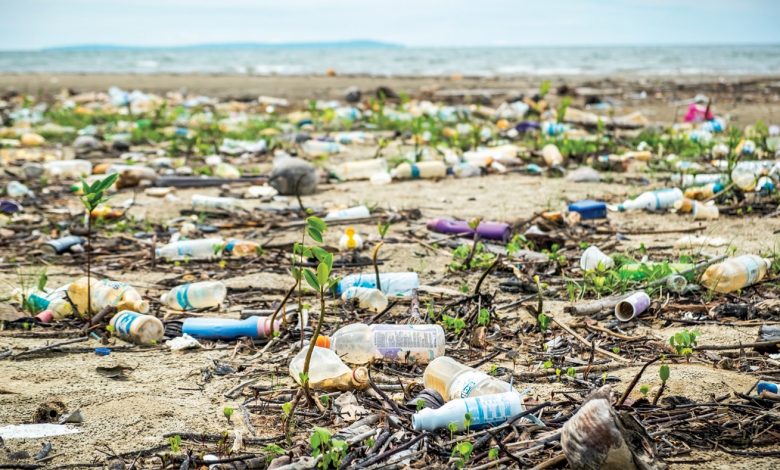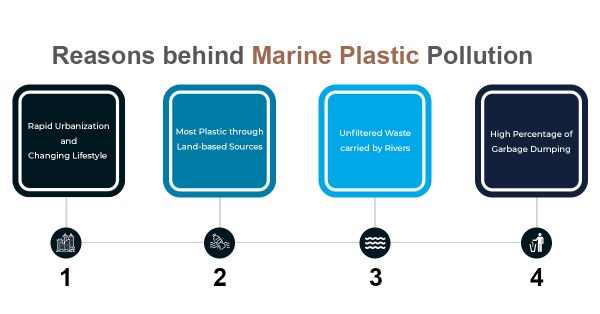Marine Plastic Waste Problem of India
[GS Paper 3 - Conservation, Environmental Pollution and Degradation]

Context – India generates 55 million tonnes of municipal waste, of which only 37 percent is treated, according to the Central Pollution Control Board. Only 60 percent of the total collected plastic waste is recycled, while the fate of the remaining 40 percent is not accounted for.
Other reports have claimed that the plastic waste generated in 2018-19 was 3.3 million tonnes per year (roughly 9,200 tonnes per day).

About Plastic Waste in India
- Plastic is a synthetic organic polymer made from petroleum with properties ideally suited for a wide variety of applications, including packaging, building and construction, household and sports equipment, vehicles, electronics and agriculture.
- The main sources of marine plastic are land-based, from urban and storm runoff, sewer overflows, beach visitors, inadequate waste disposal and management, industrial activities, construction and illegal dumping. Ocean-based plastic originates mainly from the fishing industry, nautical activities and aquaculture.
- Under the influence of solar UV radiation, wind, currents and other natural factors, plastic fragments into small particles, termed microplastics (particles smaller than 5 mm) or nanoplastics (particles smaller than 100 nm).
- Given that total municipal solid waste generation is between 55 and 65 million tonnes per day, plastic waste contributes about 5-6 per cent of total solid waste generated in India.
- India consumes about 13 million tonnes of plastic and recycles only about 4 million tonnes.
Reasons behind Marine Plastic Pollution
- Rapid Urbanization and Changing Lifestyle – Growing population, rapid urbanization, shifting consumption pattern and changing lifestyles have resulted in the mismanagement of plastic waste, leading to the accumulation of municipal solid waste.
- Most Plastic through Land-based Sources – Most of these items, especially plastic items, contribute significantly to the growing burden of marine debris. Land-based sources account for most of the plastic in the water.
- Unfiltered Waste carried by Rivers – Unaccounted waste from urban agglomerations is carried by river systems to oceans for final dumping.
- High Percentage of Garbage Dumping – The country’s coastline contributes to its ecological richness, biodiversity and economy. Every year, thousands of tonnes of garbage, composed of plastics, glass, metals, sanitary products, clothes, etc., are dumped into it. However, plastics contribute a major portion of about 60 per cent of the total marine debris that reaches the oceans.
Major Challenges associated Marine Plastic Waste
- Plastic waste is blocking sewers, threatening marine life and generating health risks for residents in landfills or the natural environment.
- Financial costs of Marine plastic Pollution – According to conservative forecasts made in March 2020, the direct harm to the blue economy of the Association of Southeast Asian Nations will be $2.1 billion per year. Boats become entangled in abandoned or discarded fishing nets or their engines may become blocked with plastic debris.
- Enormous Social Costs – Residents of coastal regions suffer from the harmful health impacts of plastic pollution and waste brought in by the tides and are inextricably linked to the fishing and tourism industry for their livelihoods.
- Food and Health – Invisible plastic has been identified in tap water, beer, salt and are present in all samples collected in the world’s oceans, including the Arctic. The transfer of contaminants between marine species and humans through the consumption of seafood has been identified as a health hazard .
- Climate Change – Plastic, which is a petroleum product, also contributes to global warming. If plastic waste is incinerated, it releases carbon dioxide into the atmosphere, thereby increasing carbon emissions.
- Tourism – Plastic waste damages the aesthetic value of tourist destinations, leading to decreased tourism-related incomes and major economic costs related to the cleaning and maintenance of the sites.
Government Initiatives
- Beach Clean-up Initiatives – The Ministry of Earth Sciences, through its attached office National Centre for Coastal Research (NCCR), has undertaken beach clean-up initiatives, awareness programmes and beach litter quantification studies at regular intervals.
- Scientific Study on Marine Pollution – Many studies have been conducted across coastal states and U Territories Puducherry, Andaman and Nicobar and Lakshadweep. NCCR has initiated monitoring of the temporal and spatial distribution of marine litter along the Indian coasts and adjacent seas in 2018, 2019 and 2021.
- Swachh Sagar, Surakshit Sagar Campaign – An average of 0.98 metric tonnes of trash per km stretch of coastline, averaging a weight concentration of 0.012 kilograms per meter square, accumulated along the Indian coastline, noted Swachh Sagar, Surakshit Sagar campaign, 2022.
- Attempt by TREE Foundation – Attempts made by some organizations in rescuing marine species from the debris are worth mentioning. TREE Foundation, a Chennai-based non-profit, has been incessantly working on this. Their efforts on this front have shed light on the magnitude of the problem of ghost nets.
- Stakeholders Approach – Over the last 20 years, through a multi-disciplinary approach involving people from all sections of society particularly unemployed youth from artisanal fishing communities, the foundation has saved and released more than 3,101,000 Olive Ridley turtles.
Way Forward
- National Marine litter Policy of India: The National Marine litter Policy of India, announced in 2018, should be formulated.
- Plastic distribution study: Marine litter and microplastics distribution and characterization study should be conducted across the Indian coast.
- Coastal city forum: A forum of coastal cities should be created for ensuring a cross-learning ecosystem and to build a synergetic association of urban local bodies and local administration located on the coast.
- Awareness campaign: Regular beach clean-up and awareness programmes should be conducted instead of annual ones.
- Effective ban: Many states claim Single Use Plastic above 50 microns is banned, but on the ground, the ban is not effective. Steps can be taken to execute such legislation.
Conclusion
Marine Plastic Pollution is killing the marine ecosystem, animals, plants, corals etc. Solving the problem of marine plastic involves a change in production and consumption habits which would help meet the Sustainable Development Goals (SDGs). Present approach of governments across the world is less than sufficient to tackle marine pollution and thus land based plastic generation should be prioritized to manage marine pollution.





.png)



